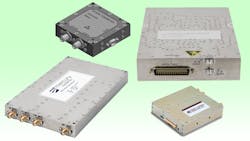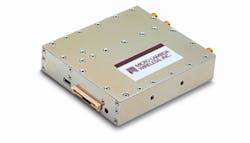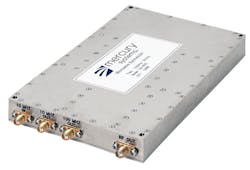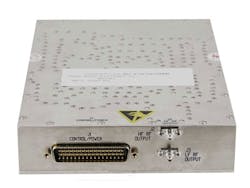Modular Synths that Meet Today’s Tough Specs
Download this article in PDF format.
Frequency synthesizers provide the RF/microwave signals so essential to the operation of many electronic defense systems. They have steadily evolved over time to provide wider bandwidths through the millimeter-wave (mmWave) frequency range, meeting growing demands for smaller step sizes (frequency resolution) with lower phase noise and faster frequency switching speeds. Recent trends for miniaturization and modularity have increased the flexibility when integrating a frequency synthesizer into a system, especially where size, weight, and power (SWaP) are concerns for smaller systems like portable radios and unmanned aerial vehicles (UAVs).
The process of specifying a synthesizer has not changed—it’s still driven by the requirements of an application and comparing key performance parameters, such as frequency range, tuning resolution, frequency switching speed, phase noise, harmonics, and SWaP. Whether in a 19-in. rack-mount assembly or a more compact module, frequency synthesizers for military and aerospace applications must perform when needed, no matter how severe the temperature, shock, and vibration conditions.
Specifying a synthesizer usually starts with frequency range. High-frequency synthesizers are available with a single fixed frequency on up to extremely wideband models covering several octaves. Choosing the right source for an application usually involves running a checklist of performance parameters. Some of those parameters may not be a consideration, such as fast switching speed for a single-frequency synthesizer. However, combinations of other performance parameters, such as low phase noise, harmonics, and spurious levels, may be critical for the same synthesizer.
Moving to Modular
Increasingly, portable/mobile defense/aerospace applications in communications, surveillance, and guidance systems are driving the development of smaller and lighter frequency synthesizers. It’s thus boosting the interest in smaller frequency-synthesizer modules for many applications, including in test-and-measurement systems.
Frequency synthesizers can be designed in many mechanical formats, from tiny surface-mount-technology (SMT) packages to legacy rack-mount enclosures for test-and-measurement and other system applications. Modular formats, such as standard VME and VPX modules with multiple interfaces for digital control, have become popular for the flexibility they bring to system installation.
Frequency synthesizers are constructed in several configurations. These include indirect formats in which low-noise output signals are generated through the combination of a reference oscillator with a higher-frequency tunable oscillator, such a dielectric resonator oscillator (DRO), voltage-controlled oscillator (VCO), or yttrium-indium-garnet (YIG) oscillator.
Using a loop filter, phase comparator, and phase-locked loop (PLL) to compare the phase of the two oscillators, the frequency accuracy and phase stability of the reference source can be translated to the RF/microwave oscillator. Fractional-N or integer-N frequency division/multiplication provides frequency resolution as a function of the reference oscillator. The reference oscillator is usually a crystal oscillator, although atomic oscillators such as rubidium (Ru) or cesium (Cs) standards have also served as references.
Direct digital synthesizers (DDSs) take advantage of ever-faster digital circuitry and digital components such as field-programmable gate arrays (FPGAs) and digital-to-analog converters (DACs), to directly generate RF/microwave waveforms from digital codes. The spectral purity of a DDS is largely determined by the DAC’s performance, such as its bit resolution, although the phase noise is a function of the reference oscillator. DDS techniques are particularly effective when multiple phase-matched or related output signals must be generated, e.g., in-phase (I) and quadrature (Q) signals for differential receivers.
Specifying Sources
The “move to modular” in frequency synthesizer design is apparent with some of the latest product designs from leading suppliers, such as Fairview Microwave, FEI-Elcom, Mercury Systems, Micro Lambda Wireless, Pasternack, Phase Matrix (a wholly owned subsidiary of National Instruments), Teledyne Microwave Solutions, and Textron Systems. Even smaller synthesizers, including those in surface-mount-technology (SMT) housings, are available from a number of companies, including Analog Devices and Synergy Microwave Corp.
For example, Micro Lambda Wireless, a long-time producer of YIG-based PLL frequency synthesizers, squeezes wideband frequency synthesizers through mmWave frequencies into modules occupying a single PXI chassis slot (Fig. 1). The firm’s MLMS-Series of wideband frequency synthesizers covers standard frequency ranges of 0.25 to 32 GHz with tuning resolution of 1 kHz when operating with an internal crystal reference oscillator.
1. Fully equipped modern wideband frequency synthesizers can fit within a single PXI slot. (Courtesy of Micro Lambda Wireless)
Although YIG-based PLL frequency synthesizers sacrifice tuning speed (compared to VCO-based frequency synthesizers), with frequency tuning speeds of 1 to 3 ms, they are noteworthy for their low phase noise, as needed for sensitive receivers. The MLMS-Series PXI modular synthesizers provide just that, with very low phase noise through 32 GHz.
For carriers from 250 MHz to 6 GHz, the single-sideband (SSB) phase noise is −75 dBc/Hz offset 100 Hz from the carrier, −94 dBc/Hz offset 1 kHz, −119 dBc/Hz offset 100 kHz, and −142 dBc/Hz offset 1 MHz from the carrier. For carriers from 28 to 32 GHz, the SSB phase noise is −63 dBc/Hz offset 100 Hz from the carrier, −83 dBc/Hz offset 1 kHz, −113 dBc/Hz offset 100 kHz, and −137 dBc/Hz offset 1 MHz from the carrier. These performance levels are measured for synthesizers operating with an internal crystal reference oscillator. The synthesizers can also be supplied with external frequency reference sources, with options for 50 to 200 MHz or 10 to 200 MHz, both at nominal input power of 0 dBm.
Standard units are designed for operating temperatures from 0 to +60°C, although custom units are also available for a wider operating temperature range of −40 to +85°C. Measuring just 2.5 × 2.5 × 0.65 in., they deliver healthy output levels from +8 to +13 dBm. Spurious levels range from −54 to -60 dBc, depending on frequency, while second harmonics are typically −8 to −20 dBc.
When frequency switching speed is more of an issue, the firm also provides VCO-based frequency synthesizers as part of its MLVS-Series LUXYN frequency synthesizer, covering a total frequency range of 50 MHz to 21 GHz. The VXI modular synthesizers achieve full-band tuning speed of 50 μs with as much as +15 dBm output power. They exhibit −125 dBc/Hz SSB phase noise offset 10 kHz from a 10-GHz carrier.
DS-3000 frequency synthesizer modules from Mercury Systems are optimized for EW and ELINT applications from 100 MHz to 20 GHz (Fig. 2). The DDS-based frequency synthesizers use list-mode tuning under four-wire SPI control for tuning speeds to 200 μs with 1-Hz frequency tuning resolution. They include mini-USB connectors and female SMA RF connectors. The synthesizer modules measure just 6.5 × 4.0 × 0.7 in. and weigh 14.5 oz. with maximum power consumption of 12 W (typically 10 W) for an operating temperature range of −30 to +70°C. They exhibit −12 dBc harmonic levels with −60 dBc maximum spurious levels.
2. These compact modular frequency synthesizers are optimized for EW and ELINT systems. (Courtesy of Mercury Systems)
The two versions of synthesizer modules demonstrate the impact of reference frequency stability on synthesizer performance. The DS-3001 is equipped with an internal 100-MHz temperature-compensated crystal oscillator (TCXO) reference with better than 2 ppm aging rate and ±0.5 ppm stability with temperature. The phase noise is typically −76 dBc/Hz offset 100 Hz from a 10-GHz carrier, −106 dBc/Hz offset 1 kHz from the same carrier, −121 dBc/Hz offset 10 kHz from 10 GHz, −124 dBc/Hz offset 100 kHz from 10 GHz, and −122 dBc/Hz offset 1 MHz from the same carrier.
When better phase-noise performance is required, the DS-3002 frequency synthesizer is supplied in the same modular format, but with a higher-stability internal 100-MHz oven-controlled crystal oscillator (OCXO) with better than 1-ppm aging rate and ±0.1-ppm stability with temperature. The phase noise with the OCXO reference is typically −96 dBc/Hz offset 100 Hz from a 10-GHz carrier, −114 dBc/Hz offset 1 kHz from the same carrier, −122 dBc/Hz offset 10 kHz from 10 GHz, −124 dBc/Hz offset 100 kHz from 10 GHz, and −122 dBc/Hz offset 1 MHz from the same carrier. Both synthesizer configurations deliver +13 dBm output power with ±2 dB flatness.
When precise frequency resolution and power control are needed in a slightly larger package, Textron Systems offers a series of frequency synthesizers for EW and automated-test-equipment (ATE) applications in two-slot VXI C size modules. They measure 10.4 × 2.4 × 14.5 in. and weigh 11.5 lbs, controlled by a VXI 3.0 interface. The compact synthesizer modules are available over a total frequency range of 3 MHz to 40 GHz with 0.04-Hz frequency resolution and an output power range of −100 to +18.5 dBm for signals to 20 GHz. Spurious content is −55 dBc at +10 dBm output power. The synthesizers are designed for use with 10-MHz reference oscillators, including external atomic Ru oscillators.
These VXI synthesizers can achieve better than 500-ns switching speed and a wide range of modulation using internal or external sources, including AM, FM, pulse modulation, differential I/Q modulation, binary phase-shift-keying (BPSK) modulation, quadrature phase-shift-keying (QPSK) modulation, and quadrature amplitude modulation (QAM). They are equipped with 2.4-mm female RF output connectors and female SMA connectors for the external reference oscillator.
Kratos General Microwave (www.kratosmed.com) offers direct and indirect frequency synthesizers in modular form (Fig. 3). While the DDS-based frequency synthesizers are capable of extremely fast frequency switching speeds (to 40 ns) with frequency- and phase-coherent switching, the indirect PLL frequency synthesizers can still deliver frequency switching speed as fast as 1 μs between two frequencies. The DDS-based synthesizers are available for tuning from 10 MHz to 18 GHz in 10-MHz steps. For slower switching speeds, the indirect PLL synthesizers provide much smaller frequency step sizes across the same frequency range. The firm offers custom synthesizer designs through 40 GHz.
3. Both DDS-based and indirect PLL-based frequency synthesizers can be supplied in modular formats. (Courtesy of Kratos General Microwave)
Some suppliers prefer to work directly with customers to fulfill system requirements for frequency synthesizers rather than offering standard models. Long-time frequency-synthesizer supplier
Wide Band Systems has a strong track record of providing synthesizers for tactical signal identification and analysis systems around the world. Switching speeds are 0.3 μs and better and spectral purity ranges from 0.5 through 18.0 GHz and beyond for the firm’s synthesizers, which come in various mechanical formats including compact modules (Fig. 4).
4. Broad frequency ranges with custom performance requirements are able to be packed into compact modules. (Courtesy of Wide Band Systems)
The low power consumption of these frequency synthesizers (less than 20 W) makes them attractive for a wide range of commercial and defense applications, including jammers, EW systems, and UAV communications systems. Additional modular synthesizer suppliers offering both standard models and extensive custom capabilities include Mini-Circuits, Synergy Microwave Corp., and Teledyne Microwave Solutions.
About the Author
Jack Browne
Technical Contributor
Jack Browne, Technical Contributor, has worked in technical publishing for over 30 years. He managed the content and production of three technical journals while at the American Institute of Physics, including Medical Physics and the Journal of Vacuum Science & Technology. He has been a Publisher and Editor for Penton Media, started the firm’s Wireless Symposium & Exhibition trade show in 1993, and currently serves as Technical Contributor for that company's Microwaves & RF magazine. Browne, who holds a BS in Mathematics from City College of New York and BA degrees in English and Philosophy from Fordham University, is a member of the IEEE.





